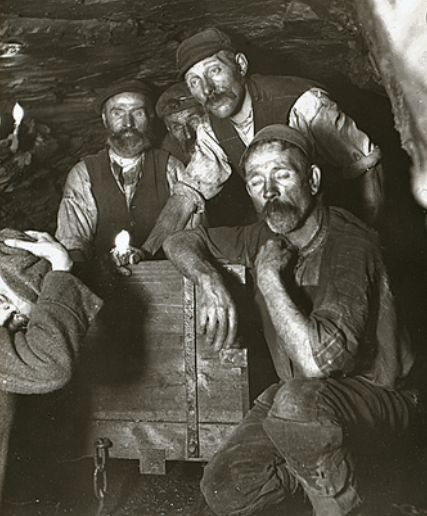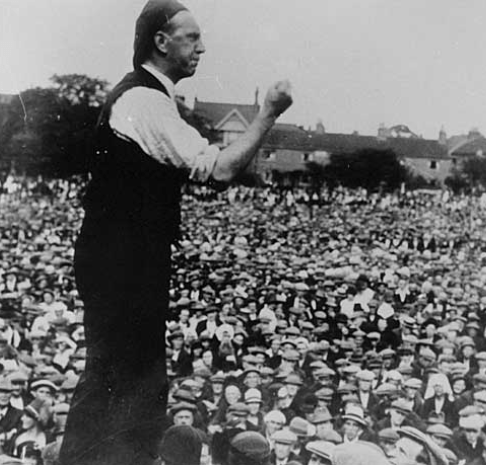By John McInally
One hundred years ago this month, the British working class were given a sharp lesson on the nature and role of the right-wing leaders in the trade union movement. Locked-out mineworkers who were resisting swingeing pay cuts were betrayed by the leaders of the so-called Triple Alliance of miners, railway and transport workers’ unions, on April 15, 1921, a day forever known as Black Friday.
It is a lesson worth studying and discussing in the trade union movement today. The labour movement suffered defeats and betrayals before and since, but few have left deeper scars or have resulted in more serious consequences than the defeat of 1921.
The capitalist class and the government of Lloyd George were so emboldened by the collapse of the Triple Alliance, as to launch a full-scale assault on workers’ pay, terms and conditions in many industries and workplaces. Many workers, disgusted and demoralised, left their trade unions in their tens, and even hundreds of thousands.
Trade union membership soared
Britain emerged from the First World War considerably weakened, with the United States as the new leading power of capitalism internationally. Yet in these years, partly as a result of the New Unionism organising the least-skilled sections of works, there was a tremendous growth of trade union membership, from 4,145,000 in 1914, to 6,533,000 at the end of the War. The short-lived economic upturn following the war saw another wave of industrial militancy, including official and unofficial action throughout Britain, including the North of England, Belfast, Glasgow. Even the police took strike action, in Liverpool and London.
This was a period of unprecedented revolutionary upheaval, both in Britain’s own backyard, with its oldest colony, Ireland, in open revolt, and wider instability across its empire. But most frightening for the ruling class, the Russian Revolution saw the establishment of the world’s first workers’ state. British workers had shown solidarity toward the new soviet state, including a refusal by dockers to load ships carrying arms to crush the revolution.
The government under Prime Minister, Lloyd George, was deeply alarmed by demands from the Miners’ Federation of Great Britain (MFGB) for higher wages, for a six-hour day and for the permanent nationalisation of the mines which had been taken under state control for the duration of the war. They even demanded an element of democratic workers’ control through union representatives.
Government of Lloyd George ignored Sankey Report
In desperation, and in order to derail threatened strike action, parliament passed the Coal Industry Commission Act in 1919. This committed Sir John Sankey to report on the future of the mining industry but the scale of pressure from the miners’ union was reflected in the fact half of the Commission’s personnel was made up of miners’ union nominees, including MFGB leader, Robert Smillie.
The government were using a time-honoured tactic of commissioning a “report” to delay or hold back advances for the working class, but although no overall conclusions were reached, the final report coming down in favour of “state ownership”, but including the option of a return to private ownership, it still horrified the government. Lloyd George, therefore, ignored the majority view in the report and returned the mines to private ownership.

The Triple Alliance of the three big unions: miners, railway workers and transport workers, had been formed in 1915, and it represented over half a million workers. It was potentially an enormously powerful formation, but unfortunately, it had right-wing leaders with the most conservative and conciliatory approach to the government and bosses.
When the mines were handed back to the bosses, they immediately launched a fierce assault by demanding swingeing pay cuts and imposing a lock-out. Those workers who were members of the Triple Alliance unions demanded full solidarity with the miners and they pressurised their leaders into calling a strike for April 15, 1921, but the leaders had no intention of seeing it through.
Triple Alliance leaders looked over the abyss
Many years after the event, in his 1952 book, In Place Of Fear, Aneurin Bevan recalled Robert Smillie telling him that Lloyd George invited the leaders of the Triple Alliance to discuss the crisis, telling them,
“Gentlemen, you have fashioned, in the Triple Alliance of the unions represented by you, a most powerful instrument. I feel bound to tell that in our opinion we are at your mercy. The army is disaffected and cannot be relied upon. Trouble has already occurred in a number of camps. We have just emerged from a great war and the people are eager for the reward of their sacrifices, and we are in no position to satisfy them. In these circumstances, if you carry out your threat and strike, you will defeat us.”
“But if you do so” continued Mr Lloyd George, “have you weighed the consequences? The strike will be in defiance of the Government of the country and by its very success will precipitate a constitutional crisis of the first importance. For, if a force arises which is stronger than the State itself, then it must be ready to take on the functions of the State or withdraw and accept the authority of the State”.
“Gentlemen” asked the Prime Minister quietly, “have you considered, and if you have, are you ready?”
“From that moment on” Bevan has Robert Smillie admitting, “we were beaten, and we knew we were.”
The real nature of class conflict laid bare
This much-quoted exchange shows how a serious capitalist leader of the calibre of Lloyd George, in the simplest terms, can expose the real nature of class conflict. It is a direct confirmation of Lenin’s comment that for the ruling class and the bosses “…behind every strike is the Hydra of revolution”. It was an understanding of the seriousness of the clash of class interests that was beyond the grasp of the leaders of the Triple Alliance unions.
In fact, there was a considerable element of bluff in what Lloyd George said. The state had in fact made serious preparations to defeat the strike and his class would not dream of handing over state power in the quiet way he implied. George already had loyal military units ready to intervene directly.
As the government prepared its response, including Emergency Powers and a military and police response, the miners’ president signalled surrender to the government by backing local pay negotiations, rather than a national agreement, despite massive opposition from the miners themselves. The message was received loud and clear by the government. The strike was called off by the Triple Alliance and while isolated groups of workers, in South Wales especially, fought on, the battle was lost.
Unwilling and unable to defend workers’ interests
In his book, Nye Bevan went on to say, “After this, the General strike of 1926 was really an anti-climax. The essential argument had been deployed in 1919. But the leaders in 1926 were in no better position to face it. They had never worked out the revolutionary implications of direct action on such a scale. Nor were they anxious to do so.”

And here, in 1921, the real role of right-wing “leadership” of those trade unions was laid bare: unwilling and unable to deliver what workers demanded of them in defence of their interests, they shrink back. Rather than a strategy to deliver victory, such leaders have either opted for open betrayal, as on Black Friday, or have used every device in their armoury to corrode solidarity, putting every possible barrier in the way of the type of coordinated, collective action that can maximise the industrial power of working people.
Industrial defeats on such a scale cannot be prettified; they represent profound setbacks, and they have consequences for all workers, organised and unorganised: vicious cuts in pay, terms and conditions were carried out that affected millions of workers, many of which the right-wing leaders accepted without a fight. Unsurprisingly, workers abandoned the unions in their hundreds of thousands.
Following the defeat in 1921, and later in 1926, the left tried to organise in the unions and on the political front too. The National Minority Movement was such a movement of trade union lefts and it scored its first notable victory when one of its members, AJ Cook, was elected general secretary of the MFGB, replacing Frank Hodges.
Cook was one of those who exemplified the role of a fighting socialist leader. Active in the Independent Labour Party and a founding member of the Communist Party, he was an inspirational miners’ union leader and was elected MFGB general secretary to the chagrin of the movement’s right-wing, not least the TUC general secretary, Fred Bramley, who attacked him as a “raving communist”.
Key necessity of organising against union right wing
Cook was an honest and decent socialist, arguably one of the most principled trade union leaders ever in Britain. Cook and other socialists understood the key necessity to of organising against the right-wing, who are not just “colleagues” with a difference opinion but are the representatives of the ruling class intruding into our movement, and who must be confronted and defeated.
In his essay Some peculiarities of English Labour leaders, written shortly after Black Friday, Russian revolutionary leader, Leon Trotsky penned a coruscating portrait of JH (‘Jimmy’) Thomas, the leader of the railway workers’ union, who attended a railway employer’s dinner. In the presence of the Tory Prime Minister Baldwin. Thomas, Trotsky wrote, “…would of course be criticised for this banquet and for his association with Baldwin, as a traitor to his class, but, he, Thomas, was not a member of any class, for the truth does not belong to any class.”

Although Thomas was a particularly obnoxious example of a right-wing trade union leader, his outlook was by no means unusual. In periods of revolutionary upheaval, the ruling class finds no greater defenders than such people. They are utterly incapable of understanding that there can be an alternative to capitalism and so they bow down before its representatives, in supplication, hoping for ‘concessions’ from fellow Christians, or at least some restraint, as they beat down those he purportedly represents. Nothing separates today’s right-wing union leaders from the Thomas’ of the past.
Defeated on the industrial plane in 1921, workers moved toward the political plane and in 1924 the first Labour government, albeit very short-lived, was elected. Labour was still led by the political equivalent of the Triple Alliance leaders, as was exemplified in 1931 by Ramsay MacDonald’s open betrayal in 1931, leading to a Tory-dominated National Government.
The need for Broad Lefts in the trade unions today
If anything, compared to those in 1921, the right-wing union leaders of the present-day are even more practised at letting down their members and their class, regardless, not only of the immediate, but also the wider and longer-term consequences. The pensions strike of 2011 saw up to two million public sector workers striking in defence of their pensions but the TUC and public sector union leaders cynically made a deal behind their backs.
They agreed to what the government asked, and in many respects to even worse. In so doing, they gave the then Coalition government a green light to impose austerity policies that systematically destroyed services and communities, with those sections of the working class least equipped and able to defend themselves subjected to the most appalling treatment.
The role of right-wingers in our movement, whether in the unions or in the Labour Party itself, has been unambiguously defined by one betrayal after the other. They do not believe there is an alternative to capitalism and so they see their role as ensuring that no force arises in the movement that is prepared to wage class war on behalf of workers with the same commitment and determination of the capitalist class does itself.
Their role is to demoralise, corrode, divide, and ultimately to police their own members and they see themselves as a kind of diplomatic corps for the workers’ movement, begging for concessions or pleading for restraint. But, when workers are under attack, never, ever, challenging the status quo. The battle against these right-wing infiltrators in the labour movement is a fundamental aspect of the wider class war in society.
The National Minority Movement of the 1920s, first in the miners’ union and then more widely, for a while set a template for building effective broad lefts in the trade unions. With many trade union elections taking place, including contests for key positions in large trade unions, it is a task which today has never had more importance.



